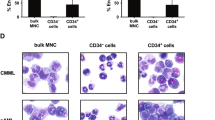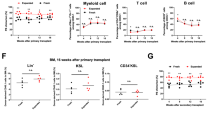Abstract
In this study the ability of malignant and normal progenitors in peripheral blood (PB) and bone marrow (BM) of CML patients in chronic phase to proliferate and produce mature progeny after transplantation into hereditary immunodeficient (SCID and NOD/SCID) mice was examined. Engraftment in NOD/SCID mice preconditioned by total body irradiation (TBI) alone was 10-fold higher than in SCID mice preconditioned by macrophage depletion and TBI, demonstrating that NOD/SCID mice are more suitable for engraftment of chronic phase CML cells. Low-density cells at cell doses of 10–30 × 106 and purified CD34+ cells at doses of approximately 0.2 × 106 engrafted NOD/SCID mice, with levels of 2 to 20% CD45+ cells with production of monocytes, granulocytes, erythroid cells, B-lymphocytes, CD34+ cells and variable frequencies of erythroid and myeloid colony-forming cells. As demonstrated by fluorescent in situ hybridization (FISH) analysis, purified human myeloid, B-lymphoid, erythroid and CD34+ cells from chimeric mouse BM contained Philadelphia-chromosome (Ph)-positive cells and Ph− cells in similar frequencies as primary cells from the CML patients. These results demonstrate that production of mature normal as well as malignant cells of multiple lineages were supported with similar efficiency. In contrast, all human erythroid and myeloid clonogenic cells detected in the mice were Ph−, which can be attributed to less efficient maintenance or more rapid differentiation of immature Ph+ cells in the mouse micro-environment. CML blast crisis cells also grew well in NOD/SCID mice, with 80–90% of human cells produced containing the Ph-chromosome. The availability of an in vivo assay that supports outgrowth of normal and malignant stem cells from chronic phase and blast crisis CML patients will facilitate examination of differential effects of growth factors, inhibitory cytokines and cytotoxic drugs on survival of normal and malignant stem cells in vivo and on progression of chronic phase CML towards blast crisis.
This is a preview of subscription content, access via your institution
Access options
Subscribe to this journal
Receive 12 print issues and online access
$259.00 per year
only $21.58 per issue
Buy this article
- Purchase on Springer Link
- Instant access to full article PDF
Prices may be subject to local taxes which are calculated during checkout
Similar content being viewed by others
Author information
Authors and Affiliations
Rights and permissions
About this article
Cite this article
Verstegen, M., Cornelissen, J., Terpstra, W. et al. Multilineage outgrowth of both malignant and normal hemopoietic progenitor cells from individual chronic myeloid leukemia patients in immunodeficient mice. Leukemia 13, 618–628 (1999). https://doi.org/10.1038/sj.leu.2401366
Received:
Accepted:
Published:
Issue Date:
DOI: https://doi.org/10.1038/sj.leu.2401366
Keywords
This article is cited by
-
Insights into the stem cells of chronic myeloid leukemia
Leukemia (2010)
-
BCR-ABL-transduced human cord blood cells produce abnormal populations in immunodeficient mice
Leukemia (2005)
-
Elucidating critical mechanisms of deregulated stem cell turnover in the chronic phase of chronic myeloid leukemia
Leukemia (2002)
-
Identification of variables determining the engraftment potential of human acute myeloid leukemia in the immunodeficient NOD/SCID human chimera model
Leukemia (2000)



